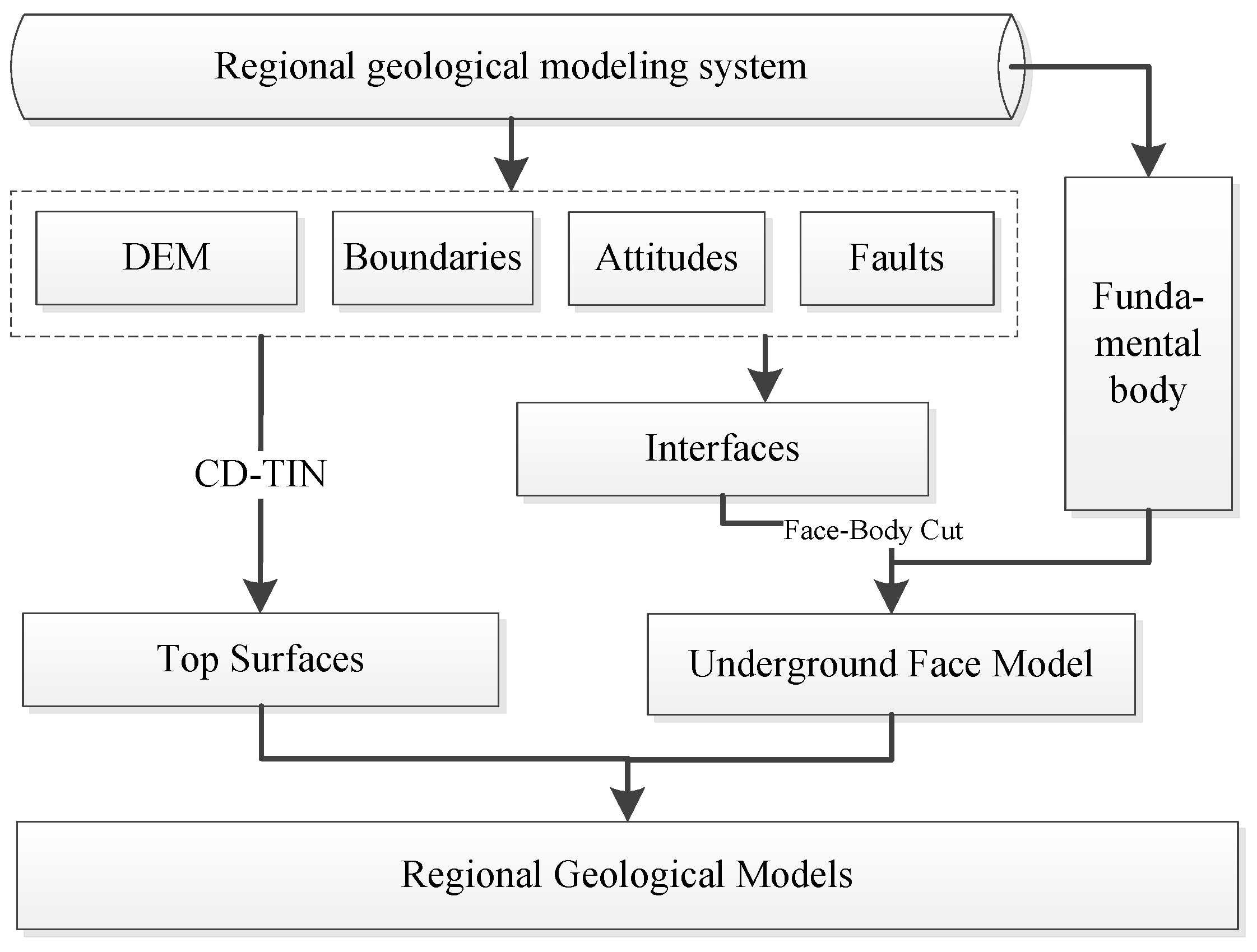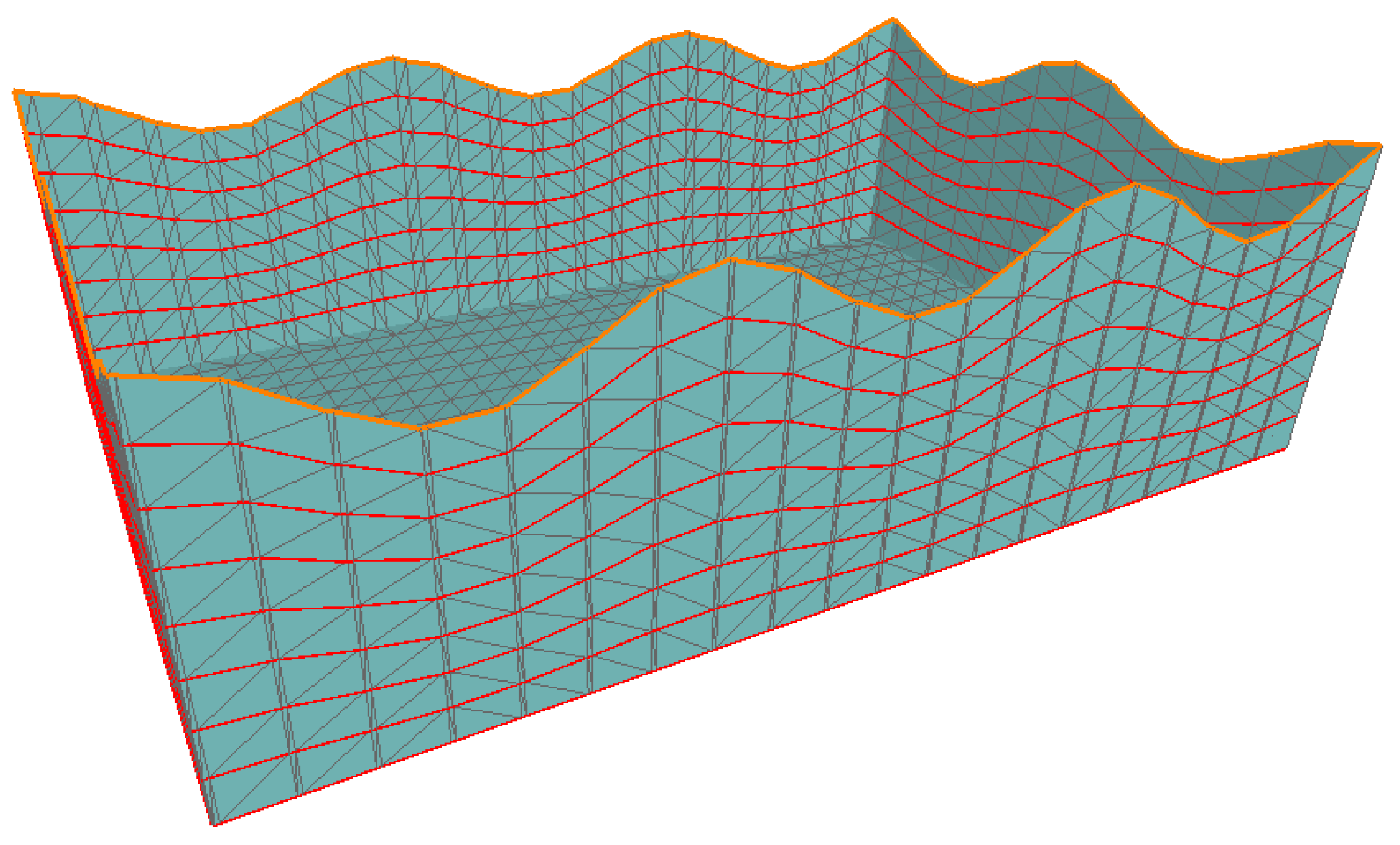Towards Automatic and Topologically Consistent 3D Regional Geological Modeling from Boundaries and Attitudes
Abstract
:1. Introduction
2. Related Work
3. Modeling Elements
3.1. Attitudes
3.2. Boundaries
4. Modeling Workflow
- (1)
- (2)
- A fundamental body that contains all of the regional geological bodies was constructed.
- (3)
- Using the attitude constraints, the geological interfaces were constructed from the geological boundaries’ arcs.
- (4)
- Using face-body Boolean calculation, the geological bodies were extracted from the fundamental body.
- (5)
- The top surfaces of the geological bodies were matched to the surface entities that were created in step 4 through their boundaries.
5. Top Surface Models
- (1)
- A triangulated irregular network (TIN) was constructed from the DEM points and the points along the boundaries.
- (2)
- The boundary was substituted into the TIN model, and the triangles that intersected the boundary were constructed until they were distributed on both sides of the boundary.
- (3)
- The triangles above the body’s top surface were deleted, and the top surface was acquired.
6. HRBF Body-Extraction Method
6.1. HRBF Interfaces
6.2. Fundamental Model
6.3. Face-Body Boolean
6.4. Extraction of the Geological Model
7. Surface Intersection
7.1. Surface-Segment Intersection
7.2. Surface–Triangle Intersection
8. Results and Analysis
8.1. Simulation of Strata
8.2. Simulation of Folds
8.3. Simulation of Faults
8.4. Realistic Geological Mapping
9. Conclusions and Future Work
Acknowledgments
Author Contributions
Conflicts of Interest
References
- Jacobsen, L.J.; Glynn, P.D.; Phelps, G.A.; Orndorff, R.C.; Bawden, G.W.; Grauch, V.J.S. US Geological Survey: A Synopsis of Three-Dimensional Modeling; US Geological Survey: Reston, VA, USA, 2011.
- Mallet, J.L. GOCAD: A Computer Aided Design Program for Geological Applications, Three-Dimensional Modeling with Geoscientific Information Systems; Springer: Houten, The Netherlands, 1992. [Google Scholar]
- Kessler, H.; Mathers, S.; Sobisch, H.G. The capture and dissemination of integrated 3D geospatial knowledge at the British Geological Survey using GSI3D software and methodology. Comput. Geosci. 2009, 35, 1311–1321. [Google Scholar] [CrossRef] [Green Version]
- Scheck-Wenderoth, M.; Lamarche, J. Crustal memory and basin evolution in the Central European Basin System—New insights from a 3D structural model. Tectonophysics 2005, 397, 143–165. [Google Scholar] [CrossRef]
- Alaei, B. Seismic Modeling of Complex Geological Structures; INTECH Open Access Publisher: Rijeka, Croatia, 2012. [Google Scholar]
- Raiber, M.; White, P.A.; Daughney, C.J.; Tschritter, C.; Davidson, P.; Bainbridge, S.E. Three-dimensional geological modelling and multivariate statistical analysis of water chemistry data to analyse and visualise aquifer structure and groundwater composition in the Wairau Plain, Marlborough District, New Zealand. J. Hydrol. 2012, 436, 13–34. [Google Scholar] [CrossRef]
- Borghi, A.; Renard, P.; Courrioux, G. Generation of 3D spatially variable anisotropy for groundwater flow simulations. Groundwater 2015. [Google Scholar] [CrossRef] [PubMed]
- McGaughey, J.; Milkereit, B. Geological models, rock properties, and the 3D inversion of geophysical data. In Proceedings of the Exploration 07: Fifth Decennial International Conference on Mineral Exploration, Toronto, ON, Canada, 9–12 September 2007; pp. 473–483.
- Calcagno, P. 3D GeoModelling for a democratic geothermal interpretation. In Proceedings of the 2015 World Geothermal Congress, Melbourne, Vic, Australia, 19–25 April 2015.
- Jia-teng, G.; Li-xin, W.; Yi-zhou, Y.; Wen-hui, Z. Three-Dimensional Modeling and Visualization Information Management of Geotechnical Engineering Investigation Sites. J. Northeast. Univer. (Nat. Sci.) 2014, 1, 122–125. [Google Scholar]
- Jia-teng, G.; Rong-bing, Z.; Li-xin, W.; Yi-zhou, Y. An automatic method for generating curvilinear geological section with stratal pinch-out. In Proceedings of the 2011 IEEE International Geoscience and Remote Sensing Symposium (IGARSS), Vancouver, BC, Canada, 24–29 July 2011.
- Jia-teng, G.; Yi-zhou, Y.; Li-xin, W.; Rong-bing, Z. A novel method for modeling complex 3D geological body with stratal pinch-out. In Proceedings of the 2011 IEEE International Geoscience and Remote Sensing Symposium (IGARSS), Vancouver, BC, Canada, 24–29 July 2011.
- Hong-bin, M.; Jia-teng, G. Study on Facial-Volumetric Mixed 3D Geological Modeling Based on Sections. J. Metal Mine. 2007, 7, 50–52. [Google Scholar]
- Ming, J.; Pan, M.; Qu, H.; Ge, Z. GSIS: A 3D geological multi-body modeling system from netty cross-sections with topology. Comput. Geosci. 2010, 36, 756–767. [Google Scholar] [CrossRef]
- Thorleifson, L.H.; Berg, R.C.; Russell, H.A.J. Geological mapping goes 3-D in response to societal needs. GSA Today 2010, 20, 27–29. [Google Scholar] [CrossRef]
- Turner, A.K. Challenges and trends for geological modelling and visualisation. Bull. Eng. Geol. Environ. 2006, 65, 109–127. [Google Scholar] [CrossRef]
- Amorim, R.; Brazil, E.V.; Samavati, F.; Sousa, M.C. 3D geological modeling using sketches and annotations from geologic maps. In Proceedings of the 4th Joint Symposium on Computational Aesthetics, Non-Photorealistic Animation and Rendering, and Sketch-Based Interfaces and Modeling, New York, NY, USA, 8–10 August 2014; pp. 17–25.
- Breen, D.E.; Mauch, S.; Whitaker, R.T. 3D scan conversion of CSG models into distance volumes. In Proceedings of the 1998 IEEE Symposium on Volume Visualization, New York, NY, USA, 19–20 October 1998.
- Tseng, Y.H.; Wang, S. Semiautomated building extraction based on CSG model-image fitting. Photogramm. Eng. Remote Sens. 2003, 69, 171–180. [Google Scholar] [CrossRef]
- Sun, T.L.; Su, C.J.; Mayer, R.J.; Wysk, R.A. Shape similarity assessment of mechanical parts based on solid models. In Proceedings of the 1995 ASME Design Engineering Technical Conference, Boston, MA, USA, 17–20 September 1995.
- You, L.H.; Zhang, J.J.; Comninos, P. Generating blending surfaces with a pseudo-Levy series solution to fourth order partial differential equations. Computing 2003, 71, 353–373. [Google Scholar] [CrossRef]
- De Araújo, B.R.; Jorge, J.A.P. Curvature dependent polygonization of implicit surfaces. In Proceedings of the 17th Brazilian Symposium on Computer Graphics and Image, Curitiba, PR, Brazil, 17–20 October 2004.
- Macedo, I.; Gois, J.P.; Velho, L. Hermite radial basis functions implicits. Comput. Graphics Forum 2011, 30, 27–42. [Google Scholar] [CrossRef]
- Hillier, M.; de Kemp, E.; Schetselaar, E. 3D form line construction by structural field interpolation (SFI) of geologic strike and dip observations. J. Struct. Geol. 2013, 51, 167–179. [Google Scholar] [CrossRef]
- Hillier, M.J.; Schetselaar, E.M.; de Kemp, E.A.; Perron, G. Three-dimensional modelling of geological surfaces using generalized interpolation with radial basis functions. Math. Geosci. 2014, 46, 931–953. [Google Scholar] [CrossRef]
- Natali, M.; Klausen, T.G.; Patel, D. Sketch-based modelling and visualization of geological deposition. Comput. Geosci. 2014, 67, 40–48. [Google Scholar] [CrossRef]
- Knight, R.H.; Lane, R.G.; Ross, H.J.; Abraham, A.P.G.; Cowan, J. Implicit ore delineation. In Proceedings of the Fifth Decennial International Conference on Mineral Exploration, Toronto, ON, Canada, 9–12 September 2007; pp. 1165–1169.
- Cowan, E.J.; Beatson, R.K.; Fright, W.R.; McLennan, T.J.; Mitchell, T.J. Rapid geological modelling. Appl. Struct. Geol. Min. Explor. Min. 2002, 36, 39–41. [Google Scholar]
- What is Micromine? Available online: http://www.micromine.com/products-downloads/micromine (accessed on 20 December 2015).
- Vulcan. Available online: http://www.maptek.com/products/vulcan/ (accessed on 20 December 2015).
- Alcaraz, S.; Lane, R.; Spragg, K.; Milicich, S.; Sepulveda, F.; Bignall, G. 3D geological modelling using new Leapfrog Geothermal software. In Proceedings of the 36th Workshop on Geothermal Reservoir Engineering, Stanford, CA, USA, 31 January–2 February 2011.
- Calcagno, P.; Chilès, J.P.; Courrioux, G.; Guillen, A. Geological modelling from field data and geological knowledge: Part I. Modelling method coupling 3D potential-field interpolation and geological rules. Phys. Earth Planet. Inter. 2008, 171, 147–157. [Google Scholar] [CrossRef]
- Bistacchi, A.; Massironi, M.; Dal Piaz, G.V.; Dal Piza, G.; Monopoli, B.; Schiavo, A.; Toffolon, G. 3D fold and fault reconstruction with an uncertainty model: An example from an Alpine tunnel case study. Comput. Geosci. 2008, 34, 351–372. [Google Scholar] [CrossRef]
- Suzuki, S.; Caumon, G.; Caers, J. Dynamic data integration for structural modeling: Model screening approach using a distance-based model parameterization. Comput. Geosci. 2008, 12, 105–119. [Google Scholar] [CrossRef]
- Wellmann, J.F.; Horowitz, F.G.; Schill, E.; Regenauer-Lieb, K. Towards incorporating uncertainty of structural data in 3D geological inversion. Tectonophysics 2010, 490, 141–151. [Google Scholar] [CrossRef]
- He, X.; Koch, J.; Sonnenborg, T.O.; Jørgensen, F.; Schamper, C.; Christian Refsgaard, J. Transition probability-based stochastic geological modeling using airborne geophysical data and borehole data. Water Resour. Res. 2014, 50, 3147–3169. [Google Scholar] [CrossRef]
- Feito, F.R.; Ogáyar, C.J.; Segura, R.J.; Rivero, M.L. Fast and accurate evaluation of regularized Boolean operations on triangulated solids. Comput. Aided Des. 2013, 45, 705–716. [Google Scholar] [CrossRef]
- Zlatanova, S.; Rahman, A.; Shi, W. Topological models and frameworks for 3D spatial objects. Comput. Geosci. 2004, 30, 419–428. [Google Scholar] [CrossRef] [Green Version]
- Hong-bin, M.; Jia-teng, G.; Qun, H.E.; Xin-rui, L. Study on Delaunay triangulation algorithm for polygon with inside islets. J. Northeast. Univer. (Nat. Sci.) 2009, 5, 733–736. [Google Scholar]
- Jia-teng, G.; Li-xin, W.; Yi-zhou, Y.; Rong-bing, Z. Towards a seamless integration for spatial objects and topography. In Proceedings of the 2012 IEEE International Conference on Geoinformatics (GEOINFORMATICS), Hong Kong, China, 15–17 June 2012.
- Hong-bin, M.; Jia-teng, G. Cut-and-sew algorithm: A new multi-contour reconstruction algorithm. J. Northeast. Univer. (Nat. Sci.) 2007, 1, 111–114. [Google Scholar]















| Point Count | Time/s |
|---|---|
| 5000 | 8 |
| 10,000 | 15 |
| 20,000 | 30 |
| 50,000 | 81 |
| 100,000 | 147 |
| 200,000 | 293 |
| Grid Length/m | Time/s |
|---|---|
| 50 | 698 |
| 70 | 324 |
| 80 | 256 |
| 90 | 215 |
| 100 | 172 |
| 200 | 87 |
| 300 | 64 |
| 400 | 61 |
| 500 | 60 |
© 2016 by the authors; licensee MDPI, Basel, Switzerland. This article is an open access article distributed under the terms and conditions of the Creative Commons by Attribution (CC-BY) license (http://creativecommons.org/licenses/by/4.0/).
Share and Cite
Guo, J.; Wu, L.; Zhou, W.; Jiang, J.; Li, C. Towards Automatic and Topologically Consistent 3D Regional Geological Modeling from Boundaries and Attitudes. ISPRS Int. J. Geo-Inf. 2016, 5, 17. https://doi.org/10.3390/ijgi5020017
Guo J, Wu L, Zhou W, Jiang J, Li C. Towards Automatic and Topologically Consistent 3D Regional Geological Modeling from Boundaries and Attitudes. ISPRS International Journal of Geo-Information. 2016; 5(2):17. https://doi.org/10.3390/ijgi5020017
Chicago/Turabian StyleGuo, Jiateng, Lixin Wu, Wenhui Zhou, Jizhou Jiang, and Chaoling Li. 2016. "Towards Automatic and Topologically Consistent 3D Regional Geological Modeling from Boundaries and Attitudes" ISPRS International Journal of Geo-Information 5, no. 2: 17. https://doi.org/10.3390/ijgi5020017






